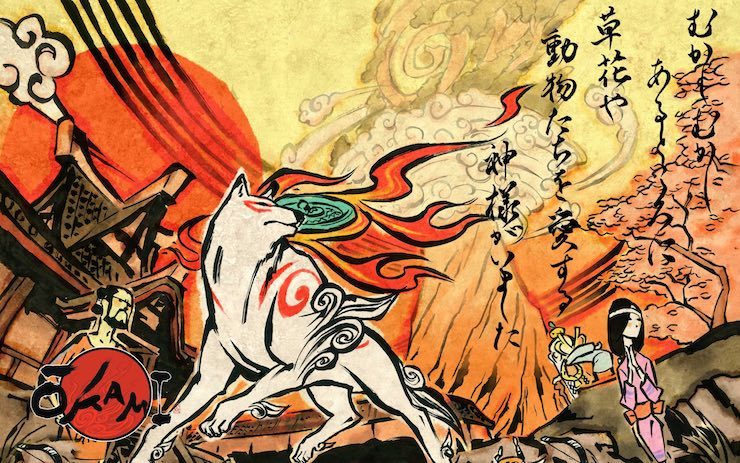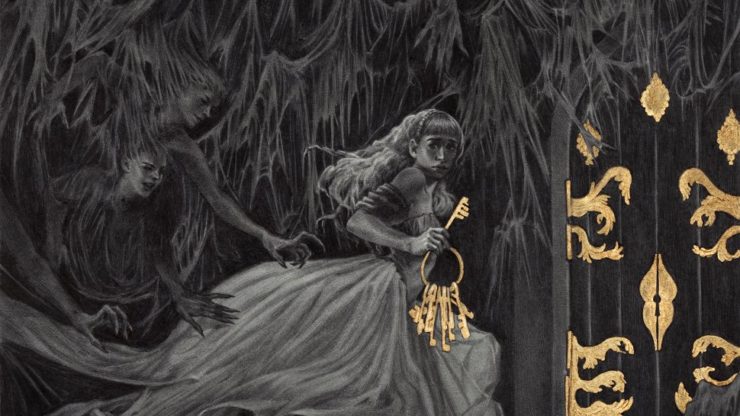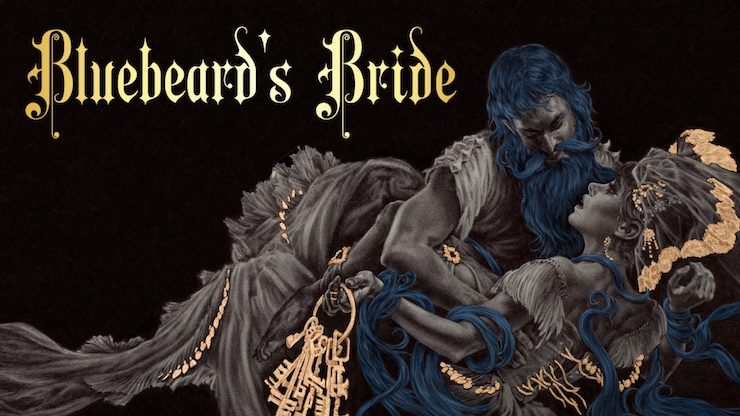What could Final Fantasy possibly have to do with cave paintings? At first glance they seem unrelated: myths, folktales, and fairy tales are our earliest forms of storytelling, while narrative video games and tabletop role-playing games are nascent art forms just coming into their own. The very old and the very new may not seem like they have much in common, but under the surface they both answer our species’ deepest desires for stories. Narrative games and the tales of our past are deeply entwined, and games can reap profound benefits from the relationship.
As a trained mythologist and a narrative designer and writer for games, I see firsthand the unique marriage between games and stories. In fact, it’s a union I occupy deeply in my own work.
Myths: Incubators for Big Stories

In the past I have written for Scion, a tabletop RPG in which players take on the roles of mortal descendants of gods from classical mythologies, such as the Greek, Hindu, and Aztec pantheons. By respecting the myths’ cultural contexts, the Scion team avoided being appropriative and instead represented a more nuanced understanding of cultural perspectives that drew from both Western and non-Western environments. I was especially fascinated with how the interpretation of an archetype changed from pantheon to pantheon. A maternal figure in Greek culture can superficially look dramatically different than a maternal figure in Aztec culture, yet still build on the underlying archetype of the “Mother.” The result of this respectful attention to how common archetypes are expressed in different cultures was deep, complex, and incredibly fun storytelling. Scion was proof positive that myths are powerful source materials for game creators, giving them access to a treasure trove where narratives can be created and remixed.
Myths answer big questions. How did we come to be? What is the meaning of life? One mythic system can explain that the world came in to being from the tears of the sun, while another explains that the world was hatched from an egg. Either way, the basic thrust of mythic plots do not often differ much across the globe or time. This cosmological and archetypal focus gives designers a natural incubator for games that want to tap into big, existential questions, especially across cultures.
Myths can be somewhat restrictive, however, when it comes to character variation. If the Mother figure in one myth acts in a way that’s completely in conflict with the whole breadth of mythic Mother figures throughout human history, then she’s most likely not rooted in the Mother archetype. That makes that figure not quite mythological—which is where fairy tales come in.
Fairy Tales: Guides Through Cultural Norms

The differences between fairy tales and myths are subtle, but significant enough that incorporating fairy tales into games yields very distinct results and a very different feel.
Myths usually represent attempts to explain how things came to be the way they are, while fairy tales create guideposts to help properly navigate the world as it exists. Don’t talk to strangers. Obey your parents. Don’t be greedy. They’re cultural enforcers, offering cues as to what a particular society values and upholds and what it will not tolerate.
While myths usually have a respected, even elevated, place in a culture, fairy tales are often dismissed as being for children—which is ironic, given their tendency toward gory and disturbing content. In the original “Cinderella,” the stepsisters’ eyes get pecked out, a detail we’d hardly put in children’s books today! The traditional versions of many Western fairy tales discuss a variety of adult topics, so using fairy tales to explore mature themes is nothing new. Adult engagement with fairy tales tends to yield a more nuanced understanding of their deeper meanings—just ask anyone who’s played Ōkami, a moving video game based on Japanese mythology and folklore. By delving into the simple and tragic world of this fairy tale and utilizing game mechanics that reflect these themes of sacrifice, rejuvenation, and redemption, children and adult gamers alike experience a full range of emotions in the novel form of one culture’s fairy tales.
That specificity in culture and locale is another unique trait of fairytales. They feature recognizable entities, relationships, and choices: the woods, witches, magical golden balls, spirits, sprites, and the things that a real person may be lucky or unlucky enough to encounter in their everyday lives. They are rooted in—and speak to—the very communities in which they are told, a long tradition of oral retelling which sometimes results in countless variants to each tale.
The multitudinous versions of each fairy tale give us insight into the most significant deviation fairy tales have from myths: they are adaptive, meaning that the stories change based on how they’re needed. Whether the protagonist (and, by extension, the audience) faces a moral quandary, an emotional exploration, or exposure to another culture, a fairy tale adopts and adapts to any given situation with much more flexibility than a myth. Fairy tales are memetic, sticking to our collective psyches through oral history. This makes them great fodder for games—but they are, so far, a regrettably underused resource.
Games in Fairy Tale Territory

The few examples we do have of games that engage with the structures and conventions of fairy tales do so through a variety of approaches. Kingdom Hearts strings together different fairy tales to form a story world, but it doesn’t fully consider the fairy tale structure. The relationship is only skin deep.
A great illustration of a game that faithfully follows the structure of a fairy tale within its mechanics is The Path. Released in 2009, The Path is an adaptation of Little Red Riding Hood, and focuses on a group of sisters that must, one by one, visit their grandmother. The rules of the game are simple: on the way there, don’t leave the path. If you follow the rules, nothing happens to you. If you don’t follow the rules, there are some interesting encounters with a wolf. The game itself is structured like a fairy tale, encompassing both a literal and emotional journey, and drives players to explore the meaning and consequences of their choices.
There is also the opportunity for games to embrace the adaptive nature of fairy tales without necessarily reinforcing the lessons imparted in the original fairy tale. A game I’ve been working on for the last two years, Bluebeard’s Bride, subverts the original lesson of the Bluebeard fairy tale. In the original story, an evil aristocrat marries a series of women and sets up a psychological trap by giving them all the keys to his castle and the freedom to explore—with the explicitly exception of a single room, which he forbids them to enter. This dilemma pushes the women into disobeying him, leading him to punish them for their disobedience by killing them and placing their bodies in the forbidden room, where the corpses wait to be discovered by the next wife. It’s a ghastly and gripping tale with sexual and oppressive undertones. The message to women is plain: it is dangerous to be curious, dangerous to disobey your husband—and you’ll do it anyway.
I co-designed this game with two other women, and from the beginning it was important to reclaim this fairy tale for ourselves. So we flipped it on its head. That didn’t mean we wrote a better ending into the game where the bride triumphs over Bluebeard through her own agency; we did quite the opposite, in fact. Much like The Path, Bluebeard’s Bride creates a space for players to explore what the fairy tale means experientially. What does it feel like to be hemmed in by anxiety and growing horror all around? To be driven slowly mad? What happens when you can’t fight your way out through violence like you can in so many other games?
Bluebeard’s Bride stands solidly within the gothic feminine horror genre, a long tradition in its own right, with movies like Rosemary’s Baby and Crimson Peak, books like Angela Carter’s The Bloody Chamber, and the web series Carmilla. I believe that recognizing and incorporating the multi-dimensional exploration characteristic of fairy tales into our game is helping to drive the game’s financial success. The increased budget has allowed us to expand the game and release more rooms and scenarios for the players to explore, adding additional depth and new conflicts.
Old Forms, New Traditions

Maybe narrative games are our new oral tradition. In the West, we rarely sit around and tell each other tales in the traditional sense, yet a growing number of people are playing RPGs, in which they spend hours around a table together telling each other stories that reflect what’s interesting and important to them. Video games are slightly different in that the social element is often removed, or secondary to the gameplay experience, but the exploration of narrative and the development of personally meaningful storytelling is central to both genres.
The success of Bluebeard’s Bride shows that games can take advantage of the vast store of fairy tales waiting at our fingertips. As fairy tales become a subject of more meaningful exploration in games, we can look forward to the same sort of iteration we see in classical fairy tales and even to the creation of new fairy tales that arise from the fears, hopes, and challenges of our contemporary cultures. Organically spawned modern folktales like the Slender Man are already inspiring games like Slender, an indication that this process is already underway.
I’m already planning my next game project, based off a reinterpretation of the Tennyo fairy tales of Japan. In these tales, a celestial being is captured by a fisherman and forced to be his wife. The children she has with him secretly sing to her, revealing the location of her magic robes, which will let her ascend back to heaven. I think I know how I’m going to turn this one on its head.
There are so many untapped ways of experiencing, so many different kinds of stories just aching to be told, so many myths and fairy tales waiting to be brought into new understanding and given new meaning. We can embrace our storytelling heritage while we create innovative narratives and mechanics that nobody has ever seen before. As we reinvent these tales, we reinvent ourselves. If we reinterpret and remix these stories in a truly authentic way, what will we find out about ourselves? How will we be reflected in our own retellings? The only way to find out is to go do it. I can’t wait to see what other designers will conjure to life.
Whitney “Strix” Beltrán is the co-creator of Bluebeard’s Bride, a narrative designer, writer, consultant, and advocate in the gaming community. She hosts the show Weekly Affirmations on the Twitch channel HyperRPG. Find out more about her at her website or on Twitter.










